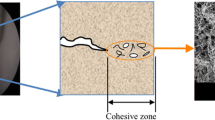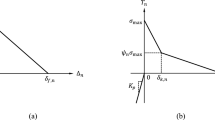Abstract
Large-scale simulation of separation phenomena in solids such as fracture, branching, and fragmentation requires a scalable data structure representation of the evolving model. Modeling of such phenomena can be successfully accomplished by means of cohesive models of fracture, which are versatile and effective tools for computational analysis. A common approach to insert cohesive elements in finite element meshes consists of adding discrete special interfaces (cohesive elements) between bulk elements. The insertion of cohesive elements along bulk element interfaces for fragmentation simulation imposes changes in the topology of the mesh. This paper presents a unified topology-based framework for supporting adaptive fragmentation simulations, being able to handle two- and three-dimensional models, with finite elements of any order. We represent the finite element model using a compact and “complete” topological data structure, which is capable of retrieving all adjacency relationships needed for the simulation. Moreover, we introduce a new topology-based algorithm that systematically classifies fractured facets (i.e., facets along which fracture has occurred). The algorithm follows a set of procedures that consistently perform all the topological changes needed to update the model. The proposed topology-based framework is general and ensures that the model representation remains always valid during fragmentation, even when very complex crack patterns are involved. The framework correctness and efficiency are illustrated by arbitrary insertion of cohesive elements in various finite element meshes of self-similar geometries, including both two- and three-dimensional models. These computational tests clearly show linear scaling in time, which is a key feature of the present data-structure representation. The effectiveness of the proposed approach is also demonstrated by dynamic fracture analysis through finite element simulations of actual engineering problems.





























Similar content being viewed by others
Notes
For reference, the tests were run on a dual-processor AMD Opteron 248 (2 × 2,193.78 MHz, 64 bits, and 16 Gb RAM).
References
Cox BN, Gao H, Gross D, Rittel D (2005) Modern topics and challenges in dynamic fracture. J Mech Phys Solids 53:565–596
Camacho GT, Ortiz M (1996) Computational modeling of impact damage in brittle materials. Int J Solids Struct 33:2899–2938
Anderson TL (2005) Fracture mechanics: fundamentals and applications, 3rd edn. CRC, Boca Raton, Florida
Belytschko T, Chen H, Xu J, Zi G (2003) Dynamic crack propagation based on loss of hyperbolicity and a new discontinuous enrichment. Int J Numer Methods Eng 58:1873–1905
Zhang Z, Paulino GH (2005) Cohesive zone modeling of dynamic failure in homogeneous and functionally graded materials. Int J Plast 21:1195–1254
Zhang Z, Paulino GH, Celes W (2007) Extrinsic cohesive modeling of dynamic fracture and microbranching instability in brittle materials. Int J Numer Methods Eng (in press)
Beall MW, Shephard MS (1997) A general topology-based mesh data structure. Int J Numer Methods Eng 40:1573–1596
Garimella RV (2002) Mesh data structure selection for mesh generation and FEA applications. Int J Numer Methods Eng 55:451–478
Remacle J-F, Karamete BK, Shephard MS (2000) Algorithm oriented mesh database. In: Proceedings of the 9th international meshing roundtable, Sandia National Laboratories, pp 349–359, October
Remacle J-F, Shephard MS (2003) An algorithm oriented mesh database. Int J Numer Methods Eng 58:349–374
Owen SJ, Shephard MS (2003) Editorial: special issue on trends in unstructured mesh generation. Int J Numer Methods Eng 58:159–160
Löhner R (1988) Some useful data structures for the generation of unstructured grids. Commun Appl Numer Methods 4:123–135
Carey GF, Sharma M, Wang KC (1988) A class of data structures for 2-d and 3-d adaptive mesh refinement. Int J Numer Methods Eng 26:2607–2622
Hawken DM, Townsend P, Webster MF (1992) The use of dynamic data structures in finite element applications. Int J Numer Methods Eng 33(9):1795–1811
Pandolfi A, Ortiz M (1998) Solid modeling aspects of three-dimensional fragmentation. Eng Comput 14:287–308
Pandolfi A, Ortiz M (2002) An efficient adaptive procedure for three-dimensional fragmentation simulations. Eng Comput 18:148–159
Celes W, Paulino GH, Espinha R (2005) A compact adjacency-based topological data structure for finite element mesh representation. Int J Numer Methods Eng 64(11):1529–1565
Celes W, Paulino GH, Espinha R (2005) Efficient handling of implicit entities in reduced mesh representations. J Comput Inf Sci Eng Spec Issue Mesh-Based Geometric Data Process 5(4):348–359
Klein PA, Foulk JW, Chen EP, Wimmer SA, Gao H (2001) Physics-based modeling of brittle fracture: cohesive formulations and the applications of meshfree methods. Sandia National Laboratory, Technical Report, SAND 2001-8009
Ortiz M, Pandolfi A (2003) Finite-deformation irreversible cohesive elements for three-dimensional crack-propagation analysis. Int J Numer Methods Eng 44:1267–1282
Cirak F, Ortiz M, Pandolfi A (2005) A cohesive approach to thin-shell fracture and fragmentation. Comput Methods Appl Mech Eng 194:2604–2618
Song SH, Paulino GH, Buttlar WG (2007a) A bilinear cohesive zone model tailored for fracture of asphalt concrete considering viscoelastic bulk material. Eng Fract Mech 73(18):2829–2848
Song SH, Paulino GH, Buttlar WG (2007b) Simulation of crack propagation in asphalt concrete using an intrinsic cohesive zone model. ASCE J Eng Mech 132(11):1215–1223
Espinosa HD, Zavattieri PD (2003) A grain level model for the study of failure initiation and evolution in polycrystalline brittle materials. Part 1 theory and numerical implementation. J Mater 35:333–364
Zavattieri P, Espinosa HD (2001) Grain level model analysis of crack initiation and propagation in brittle materials. Acta Mater 49:4291–4311
Xu X, Needleman A (1995) Numerical simulations of dynamic crack growth along an interface. Int J Fract 74:289–324
Pandolfi A, Krysl P, Ortiz M (1999) Finite element simulation of ring expansion and fragmentation: the capturing of length and time scales through cohesive models of fracture. Int J Fract 95:279–297
Matous K, Geubelle PH (2006) Multiscale modelling of particle debonding in reinforced elastomers subjected to finite deformations. Int J Numer Methods Eng 65:190–223
Iesulauro E, Ingraffea AR, Arwade S, Wawrzynek PA (2002) Simulation of grain boundary decohesion and crack initiation in aluminum microstructure models. In: Reuter WG, Piascik RS (eds) Fatigue and fracture mechanics: 33rd volume, ASTM STP 1417. American Society for Testing and Materials, West Conshohocken, pp 715–728
Weiler K (1986) Topological structures for geometric modeling, Ph.D. Thesis, Rensselaer Polytechnic Institute, New York
Weiler K (1988) The radial edge structure: a topological representation for non-manifold geometric boundary modeling. In: Wozney M, McLaughlin H, Encarnacao J (eds) Geometric Modeling for CAD Applications, North-Holland, pp 3–36
Mäntylä M (1988) An introduction to solid modeling. Computer Science Press, Rockville
Wawrzynek PA, Ingraffea AR (1987) Interactive finite element analysis of fracture processes: an integrated approach. Theor Appl Fract Mech 8:137–150
Martha LF, Wawrzynek PA, Ingraffea AR (1993) Arbitrary crack representation using solid modeling. Eng Comput 9:63–82
Paulino GH, Jin Z-H, Dodds RH Jr (2003) Failure of functionally graded materials. In: Karihaloo B, Knauss WG (eds) Comprehensive structural integrity, vol 2, Chapter 13. Elsevier Science, Amsterdam, pp 607–644
Jin Z, Paulino GH, Dodds RH Jr (2003) Cohesive fracture modeling of elastic–plastic crack growth in functionally graded materials. Eng Fract Mech 70:1885–1912
De Floriani L, Hui A (2003) A scalable data structure for three-dimensional non-manifold objects. In: Proceedings of the Eurographics symposium on geometry processing, Aachen, Germany, pp 72–82
Kalthoff JF, Winkler S (1987) Failure mode transition at high rates of shear loading. In: Chiem CY, Kunze HD, Meyer LW (eds) Proceedings of the international conference on impact loading and dynamic behavior of materials, Bremen, Germany, pp 185–195
Belytschko T, Chen H, Xu J, Zi G (2003) Dynamic crack propagation based on loss of hyperbolicity and a new discontinuous enrichment. Int J Numer Methods Eng 58:1873–1905
John R, Shah SP (1990) Mixed-mode fracture of concrete subjected to impact loading. J Struct Eng 116:585–602
Ruiz G, Pandolfi A, Ortiz M (2001) Three-dimensional cohesive modeling of dynamic mixed-mode fracture. Int J Numer Methods Eng 52:97–120
Acknowledgments
Paulino gratefully acknowledges the support from NASA-Ames, Engineering for Complex Systems Program, and the NASA-Ames Chief Engineer (Dr. Tina Panontin) through grant NAG 2-1424. Both Celes and Espinha would like to thank the Tecgraf laboratory at PUC-Rio, which is mainly funded by the Brazilian oil company, Petrobras.
Author information
Authors and Affiliations
Corresponding author
Rights and permissions
About this article
Cite this article
Paulino, G.H., Celes, W., Espinha, R. et al. A general topology-based framework for adaptive insertion of cohesive elements in finite element meshes. Engineering with Computers 24, 59–78 (2008). https://doi.org/10.1007/s00366-007-0069-7
Received:
Accepted:
Published:
Issue Date:
DOI: https://doi.org/10.1007/s00366-007-0069-7




